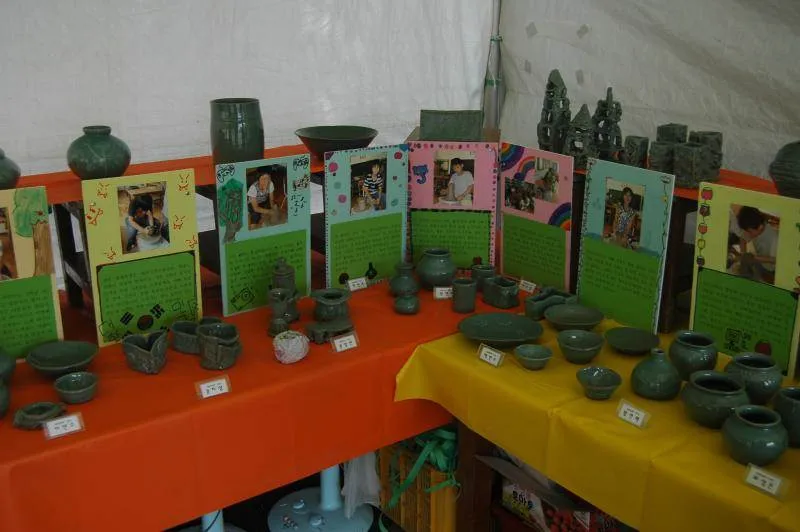
At the risk of treading on Brian in Jeollanam-do’s territory, the Lady in Red and I headed down to southwest South Korea to check out the 38th Gangjin Celadon Festival. Korea has over 1,000 years of pottery-making history, and the festival is designed to get you interacting and learning about it. The festival has been deemed the best festival in Korea by the Ministry of Culture, Sports, and Tourism (note: not tourists) for 9 years in a row. My take? It’s worth attending if you’re already interested, but more than a few things will make you say ‘What the Kimchi?’
At its simplest, celadon is pottery with a colored glaze. Historically, pale green to intense green is the most common, although other colors have been made. There’s plenty of products that have been made in the style – pots, vases, bowls, spoon rests, and much more. What the brochure doesn’t tell you is that the Mongol invasions and persecution from the Joseon Dynasty (the one following Goryeo) stopped celadon production in its tracks.

Fortunately, there are plenty of artisans around to help the mere mortals.

A collection of elementary-school pottery. No indication on whether it was for sale, but this was merely the tip of the iceberg (er, glob of clay off the spinning wheel?).

The event combines both hands-on stuff and stuff to see; this is one of the former. Pay a few thousand won, then get a piece of cardboard to create a mosaic from the scrap and broken pieces from former pots. Also nearby was a Celadon Paper Folding tent (create a celadon ‘vase’ like a jigsaw puzzle) and a couple other creative endeavors.

The work of university students – we haven’t even gotten to the professionals yet. Prices ranged from 2,000 won ($1.50 US) on up. To make that pottery purchase a little more enticing, we received coupons worth 5,000 won off of anything in the festival.

‘Celadon’ chocolate – cute as a gift, but a bit expensive for anything else.

A reminder that ‘celadon’ can incorporate almost any number of colors.

Not far from the festival street is a number of tents offering plenty of other products completely unrelated to celadon or pottery. Not pictured is a table of hats, a table of jewelry, and a table of ocarinas and other musical instruments. Don’t forget about the battery operated orange dogs and a couple classic carnival games. Wait, what?

Another example of ‘What the Kimchi is going on here?!’ – I’m speechless.

At least it’s quasi-related to celadon – people paid a couple thousand won to throw a baseball at the pottery to try and break it.
While it wasn’t perceived as a highlight, the large white tent contained the professionals selling their wares – at professional prices, of course:

Sure, all the nice vases and pots are there – but this is what caught my eye. Talk about a conversation piece. With dozens of artists and plenty of beautiful pottery to see, the chance to buy is certainly there; that few seemed genuinely interested in selling may have deterred some of the casual passers-by.

A 500 year old Japanese elm tree – in true Korean fashion, it is listed as 16 meters high, with girth of the branches measuring from 1.45 meters to 3.88 meters. One legend claims a woodcutter who cut off a branch met a sudden death. All I know is that a hot day demands some shade to rest around.

Beyond the festival is plenty of other sights. Even without the temporary festival, this permanent museum offered a fair amount to see. The ‘Celadon Art Festival 2010’ exhibit is open from August 7th to November 30th, and offers a number of traditional pieces, as well as a few unusual ones:

In the interest of keeping this post relatively short – and getting you to see things for yourself – I’ll end this post here. There’s plenty to see if you’re interested in pottery, that’s for sure. It doesn’t really do a lot to encourage new interest, which is a bit disappointing. I saw nothing at the festival to explain the actual history of celadon production, nor did I see any of the actual (or restored) kilns. That means you’re left appreciating the product with little understanding of the process. A few maps showed the festival area well – in Korean only – and seemed to imply that there was little to see in the immediate area. There’s other stuff to see (as a future blog post on Nammireuksa and the biggest Buddha in Korea will show), but you wouldn’t know it from the festivals’ advertising.
Directions to Gangjin Celadon Festival: Get to Gangjin in Jeollanam-do. Buses leave from Seoul six times a day, and take about 4 1/2 hours to arrive. Alternatively, take a train from Yongsan station to Gwangju (9 times a day) and catch a frequent intercity bus to Gangjin from there. Once at Gangjin Bus Terminal, a shuttle bus can transport you to the festival grounds. The bus leaves at the top of the hour and takes about 20 minutes. TAKE THE SHUTTLE BUS – a taxi from the bus terminal costs almost 20,000 won. Admission: 7,000 won (includes 5,000 won worth of coupons). Festival ends August 15, 2010.



> Another example of 'What the Kimchi is going on here?!' – I'm speechless.
Man, those singing robots are their own justification. I pity the fool who doesn't appreciate them.